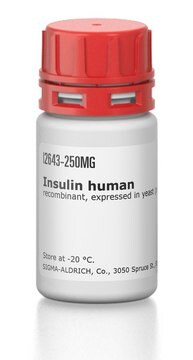11376497001
Roche
Insulina
recombinant (yeast)
Sinônimo(s):
Insulin human
About This Item
Produtos recomendados
Nível de qualidade
esterilidade
non-sterile; 0.2 μm filtered
Ensaio
>98% (SDS-PAGE)
forma
lyophilized (clear, colorless solution after reconstitution)
peso molecular
5,700 Da
embalagem
pkg of 100 mg
fabricante/nome comercial
Roche
técnica(s)
cell culture | mammalian: suitable
Impurezas
<0.1 EU/μg endotoxin (LAL test)
solubilidade
water: soluble
nº de adesão UniProt
temperatura de armazenamento
2-8°C
chave InChI
PBGKTOXHQIOBKM-FHFVDXKLSA-N
Informações sobre genes
human ... INS(3630)
Procurando produtos similares? Visita Guia de comparação de produtos
Categorias relacionadas
Descrição geral
Especificidade
Aplicação
Ações bioquímicas/fisiológicas
Outras notas
Qualidade
Note: 1 EU corresponds to 0.1ng
Sequência
Definição da unidade
forma física
Nota de preparo
Recommended concentration for serum-free cell culture is 1-10 μg/ml.
The concentration of insulin required for stimulation of cell growth in almost all cases is extraordinarily high compared with the physiological concentration. Insulin may be mimicking insulin-like growth factors (IGFs, somatomedins) for some cell lines, and high insulin concentrations may be necessary to occupy receptors which have a high affinity for IGFs and a lower affinity for insulin.
Working solution: Dissolve Insulin, human, recombinant (100 mg or 500 mg), in sterile, double-dist. water (final concentration: 10 mg/ml).
Storage conditions (working solution): -15 to -25 °C
The reconstituted, undiluted solution is stable at -15 to -25 °C.
Note: Avoid repeated freezing and thawing.
Reconstituição
geralmente comprado junto com este produto
Classe de risco de água (WGK)
nwg
Ponto de fulgor (°F)
Not applicable
Ponto de fulgor (°C)
Not applicable
Certificados de análise (COA)
Busque Certificados de análise (COA) digitando o Número do Lote do produto. Os números de lote e remessa podem ser encontrados no rótulo de um produto após a palavra “Lot” ou “Batch”.
Já possui este produto?
Encontre a documentação dos produtos que você adquiriu recentemente na biblioteca de documentos.
Os clientes também visualizaram
Nossa equipe de cientistas tem experiência em todas as áreas de pesquisa, incluindo Life Sciences, ciência de materiais, síntese química, cromatografia, química analítica e muitas outras.
Entre em contato com a assistência técnica










